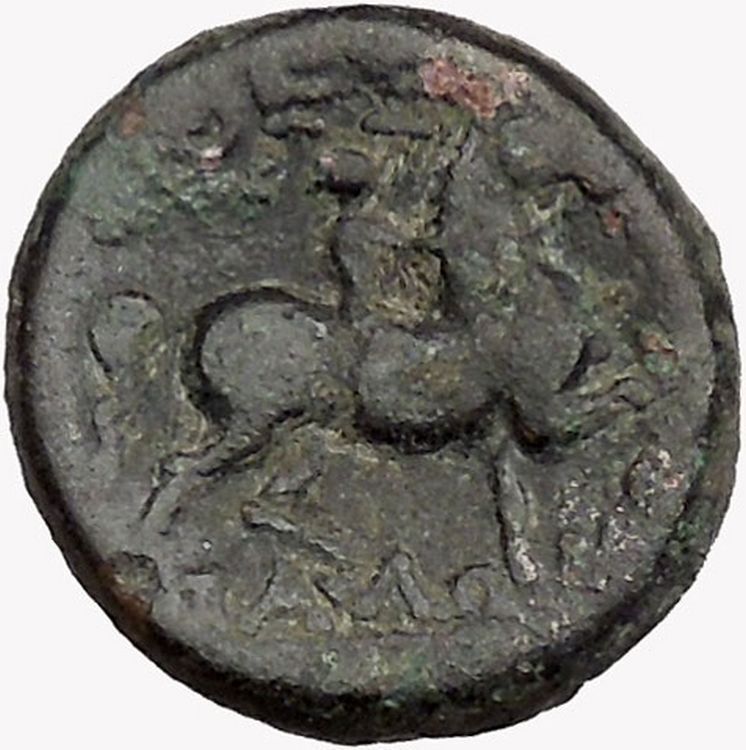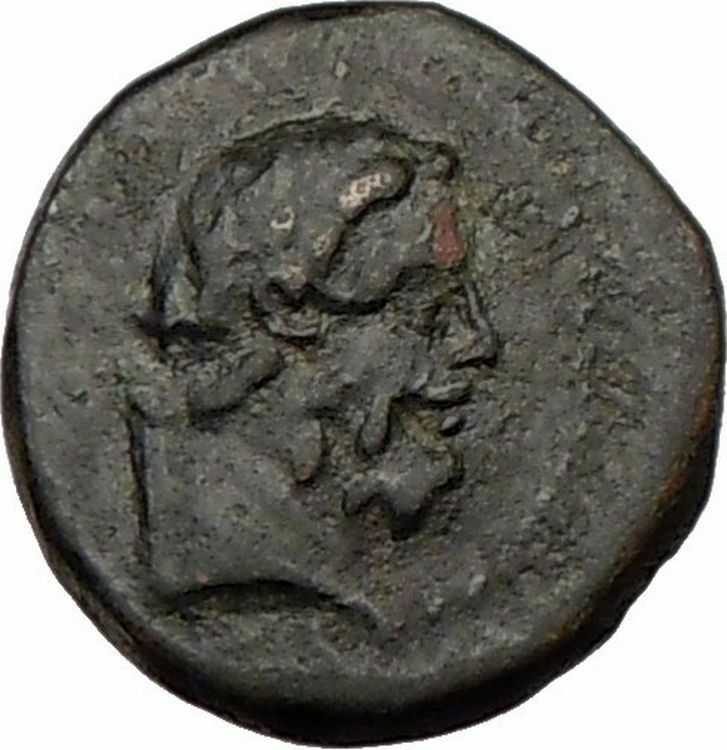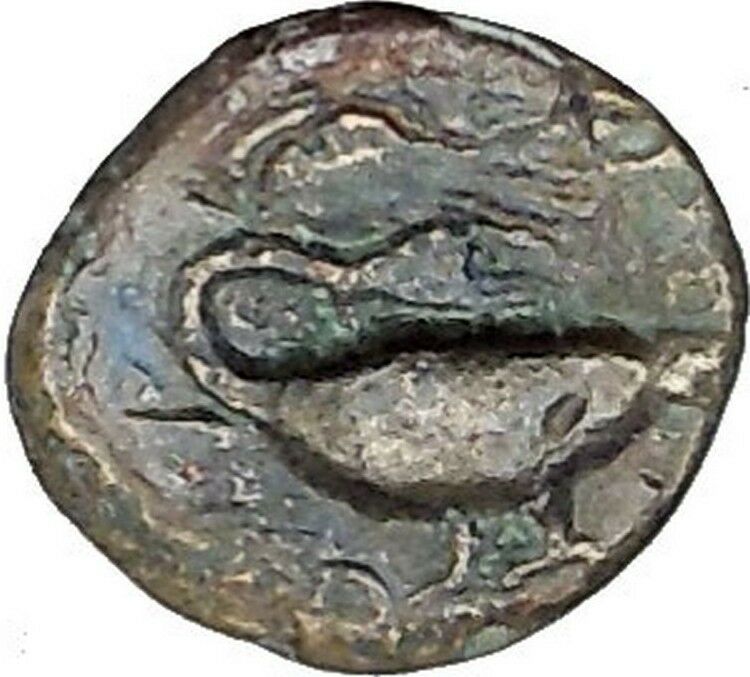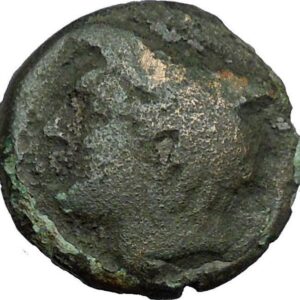|
Greek Coin of
Kersebleptes – King of Thrace: 359-340 B.C.
Bronze 12mm (2.20 grams)
Reference: SNG Copenhagen 1070-1071.
Female head right.
KEP, Two-handled cup or vase; barley grain below.
You are bidding on the exact item pictured, provided with a Certificate of Authenticity and Lifetime Guarantee of Authenticity.
Cersobleptes (Greek: Kερσoβλέπτης), also spelled Kersobleptes, Kersebleptes, and Cersebleptes, was son of Cotys, king of Thrace, on whose death in 358 BC he inherited the kingdom in conjunction with Berisades and Amadocus II, who were probably his brothers. He was very young at the time, and the whole management of his affairs was assumed by the Euboean adventurer, Charidemus, who was connected by marriage with the royal family. The area controlled by Cersobleptes was east of the river Hebrus.
Charidemus took on a prominent role in the ensuing contests and negotiations with Athens for the possession of the Thracian Chersonese, with Cersobleptes appearing throughout as a mere puppet of Charidemus. The peninsula seems to have been finally ceded to the Athenians in 357 BC, though they did not occupy it with their settlers until 353 BC; although Isocrates is less certain about the earlier date. For some time after the cession of the Chersonese, Cersobleptes continued to assiduously court the favour of the Athenians, being perhaps restrained from aggression by the fear of the Athenian fleet based in the Hellespont.
On the death of Berisades, before 352 BC, Cersobleptes conceived, or more correctly Charidemus conceived for him, the idea of excluding the children of the deceased prince from their inheritance, and obtaining possession of all the dominions of Cotys. It was with this objective in mind that Charidemus gained from the Athenian people, through his party among the orators, the decree in his favour. In response to this outcome, Demosthenes delivered a speech (which still exists) through which he unsuccessfully tried to impeach the mover of the decree, Aristocrates. From a passing reference in Demosthenes’ oration, it appears that Cersobleptes had been negotiating with king Philip II of Macedonia for a combined attack on the Chersonese. However, these negotiations came to nothing as a consequence of the refusal of Amadocus to allow Philip a passage through his territory. But after the passing of the Athenian decree, Philip became the enemy of Cersobleptes, and in 352 BC made a successful expedition into Thrace, gained a firm ascendancy in the country and took a son of Cersobleptes as a hostage.
Both Cersobleptes and Amadocus appear to have been subjected by Philip early in 347 BC, not long after Cetriporis, the son and successor of Berisades, suffered the same fate. The two rulers, having appealed to the Macedonian ruler to arbitrate a dispute between them, were then been forced to acknowledge his suzerainty when the “judge” showed up with an army.
At the time of the peace between Athens and Philip in 346 BC, Cersobleptes was again involved in hostilities with the Macedonian king, who was in Thrace when the second Athenian embassy arrived at his capital Pella, and did not return to give them audience until he had completely conquered Cersobleptes’ lands.
In the course of the next three years, Cersobleptes seems to have recovered strength sufficient to throw off the Macedonian yoke, and, according to Diodorus, persisted in his attacks on the Greek cities located on the Hellespont. Accordingly, in 343 BC, Philip again marched against him, defeated him in several battles, and reduced him to the condition of a tributary.
 Thrace (demonym Thracian; Bulgarian: Тракия, Trakiya, Greek: Θράκη, Thráki, Turkish: Trakya) is a historical and geographic area in southeast Europe. As a geographical concept, Thrace designates a region bounded by the Balkan Mountains on the north, Rhodope Mountains and the Aegean Sea on the south, and by the Black Sea and the Sea of Marmara on the east. The areas it comprises are southeastern Bulgaria (Northern Thrace), northeastern Greece (Western Thrace), and the European part of Turkey (Eastern Thrace). The biggest part of Thrace is part of present-day Bulgaria. In Turkey, it is also called Rumelia. The name comes from the Thracians, an ancient Indo-European people inhabiting Southeastern Europe. Thrace (demonym Thracian; Bulgarian: Тракия, Trakiya, Greek: Θράκη, Thráki, Turkish: Trakya) is a historical and geographic area in southeast Europe. As a geographical concept, Thrace designates a region bounded by the Balkan Mountains on the north, Rhodope Mountains and the Aegean Sea on the south, and by the Black Sea and the Sea of Marmara on the east. The areas it comprises are southeastern Bulgaria (Northern Thrace), northeastern Greece (Western Thrace), and the European part of Turkey (Eastern Thrace). The biggest part of Thrace is part of present-day Bulgaria. In Turkey, it is also called Rumelia. The name comes from the Thracians, an ancient Indo-European people inhabiting Southeastern Europe.
The historical boundaries of Thrace have varied. Noteworthy is the fact that, at an early date, the ancient Greeks employed the term “Thrace” to refer to all of the territory which lay north of Thessaly inhabited by the Thracians, a region which “had no definite boundaries” and to which other regions (like Macedonia and even Scythia) were added. In one ancient Greek source, the very Earth is divided into “Asia, Libya, Europa and Thracia”. As the knowledge of world geography of the Greeks broadened, the term came to be more restricted in its application: Thrace designated the lands bordered by the Danube on the north, by the Euxine Sea (Black Sea) on the east, by northern Macedonia in the south and by the Illyrian lands (i.e. Illyria) to the west. This largely coincided with the Thracian Odrysian kingdom, whose borders varied in time. During this time, specifically after the Macedonian conquest, the region’s old border with Macedonia was shifted from the Struma River to the Mesta River. This usage lasted until the Roman conquest. Henceforth, (classical) Thrace referred only to the tract of land largely covering the same extent of space as the modern geographical region. In its early period, the Roman province of Thrace was of this extent, but after the administrative reforms of the late 3rd century, Thracia’s much reduced territory became the six small provinces which constituted the Diocese of Thrace. The medieval Byzantine theme of Thrace contained only what today is Eastern Thrace.
The largest cities of Thrace are: İstanbul (European side), Plovdiv, Burgas, Stara Zagora, Haskovo, Edirne, Çorlu and Tekirdag.
Most of the Bulgarian and Greek population are Christians, while most of the Turkish inhabitants of Thrace are Muslims.
|





 Thrace (demonym Thracian; Bulgarian: Тракия, Trakiya, Greek: Θράκη, Thráki, Turkish: Trakya) is a historical and geographic area in southeast Europe. As a geographical concept, Thrace designates a region bounded by the Balkan Mountains on the north, Rhodope Mountains and the Aegean Sea on the south, and by the Black Sea and the Sea of Marmara on the east. The areas it comprises are southeastern Bulgaria (Northern Thrace), northeastern Greece (Western Thrace), and the European part of Turkey (Eastern Thrace). The biggest part of Thrace is part of present-day Bulgaria. In Turkey, it is also called Rumelia. The name comes from the Thracians, an ancient Indo-European people inhabiting Southeastern Europe.
Thrace (demonym Thracian; Bulgarian: Тракия, Trakiya, Greek: Θράκη, Thráki, Turkish: Trakya) is a historical and geographic area in southeast Europe. As a geographical concept, Thrace designates a region bounded by the Balkan Mountains on the north, Rhodope Mountains and the Aegean Sea on the south, and by the Black Sea and the Sea of Marmara on the east. The areas it comprises are southeastern Bulgaria (Northern Thrace), northeastern Greece (Western Thrace), and the European part of Turkey (Eastern Thrace). The biggest part of Thrace is part of present-day Bulgaria. In Turkey, it is also called Rumelia. The name comes from the Thracians, an ancient Indo-European people inhabiting Southeastern Europe.




